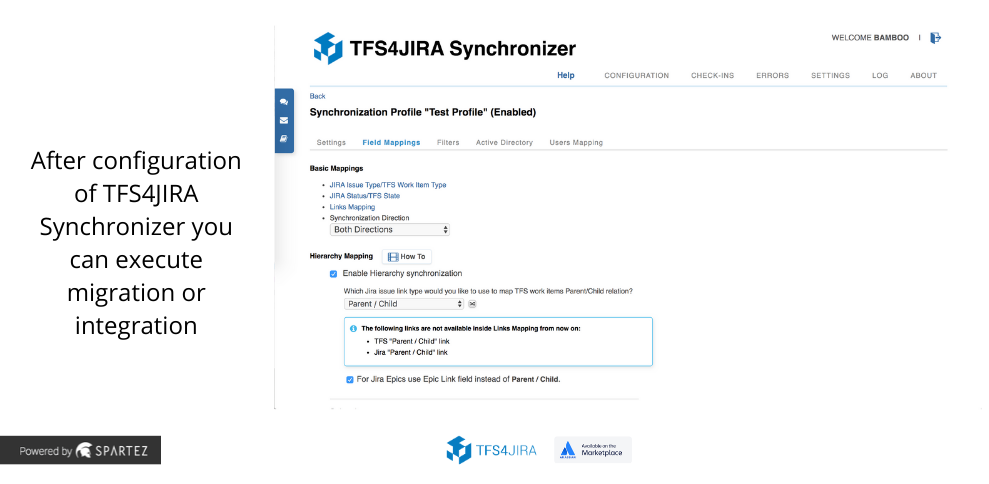Our quick guide to migrating Azure DevOps to Jira
These can be high-stakes, complex processes that leave little room for error – here’s how to do it right.
Azure DevOps Jira Integration is a hot topic for a lot of Jira administrators. Wouldn’t it be great if you could start fresh whenever you adopt a new software tool? Unfortunately, in most cases, we can’t just start from scratch. We need continuity, and to preserve our data in the new system. And when it comes to migrations or integrations of business-critical software such as Jira and Azure DevOps, stakes are high, and the likelihood of errors is even higher. This is the reason most admins who have experience working with migrations get goosebumps just thinking about these processes. But it doesn’t have to be that way.
So, if you want to integrate Azure DevOps with Jira, or migrate your data from one solution to the other, this guide from Spartez will show you how to do it right.
When should you migrate or integrate between Jira and Azure DevOps?
As your organization grows, or your company has engaged in a merger or acquisition, you’ll likely need to consolidate the tools your teams are using. Often, this means integrating Azure DevOps with Jira, or moving from one solution to the other.
These can be high-stakes, complex processes that leave little room for error. Copying tasks manually or developing your own solution can be time-consuming and expensive, and still wouldn’t guarantee success.
So maybe you explore the world of software companies that can perform data migrations and integrations for you. While an experienced consultant will likely get the job done proficiently, this solution is quite expensive, and can often take a great deal of time to complete – deal-breakers for many organizations with limited time and resources. This is where the Atlassian Marketplace comes in handy.
Spartez Software, originally an Atlassian Solution Partner, is now a Marketplace Vendor. Every app that we’ve developed was created as a solution to our own internal needs. One of the first apps we developed for the Atlassian Marketplace is TFS4JIRA. Launched in 2011, it is still one of the best selling apps in the Atlassian Marketplace, and currently a staff pick from Atlassian. Our goal is to help teams execute migrations and integrations with an out-of-the-box solution that requires only the configuration of the TFS4JIRA synchronizer, where you specify projects and fields that need to be synced or migrated. In addition to the app itself, from day one we decided to offer unparalleled support with the goal of providing the best customer experience possible. Eight years and thousands of migrations later, we’re confident that any organization interested in migrating from Azure DevOps to Jira – or integrate both solutions at once – will find the app useful.
Why should you migrate or integrate Azure DevOps to Jira?
This is the most important question to consider before going any further. What are the advantages of Jira over Azure DevOps? If you don’t know, you may end up simply copying your current workflow into a new tool, which is not ideal. So ask yourself, and your key stakeholders: how can you best use Jira to its full potential to benefit your environment?
The primary advantage of Jira is its powerful project configuration. Teams can easily customize their project workflow, issue types, and fields for the board they want and need, without affecting another project’s customizations. You can also customize your dashboard with information you really need. Finally, you have access to more than a dozen real-time reports in Jira, giving actionable insights into how the team is performing sprint over sprint.
Planning your migration
Once you’re familiar with both systems and understand the advantages of Jira, it’s time to prepare the action plan.
- Define your requirements. Identify what type of information you need to migrate – descriptions, assignees, statuses, attachments, custom fields, dates, etc. What about custom fields? Will you need all of them? This is the time to cut as much as possible for a clean and effective Jira experience.
- Next, define the time range for the data you need to sync. Is it last year? Last quarter? Try to archive what you can and migrate only the data that is really crucial.
- Once you know what data that needs to be migrated, build a skeleton environment and sketch a transition model.

Choose an integration tool
Once you’re equipped to execute the migration, all you need is a tool that will support you through the process. When choosing such a tool, it’s important to think about data security. Does the app store your data? How is it stored? Can you manage it easily? It’s always safer to have full control over your data and process, so you should ensure your solution of choice can be installed within your company network, behind the firewall, to protect the data controlled by company admins.
It’s also worth checking customer reviews, app ratings, and the number of active installations.
Verify the provider of the Jira plugin as well – what level of support is offered? Is it included in the price? How long have they been on the market? You’ll want to choose a provider that’s reliable and experienced.

Migrate sample data to a test environment
Next, it’s time to migrate sample data. If that test is successful, you’ll execute the migration or synchronization of your staging environment. Finally, if all goes according to plan, execute the migration or integration on your production environment.
Azure DevOps Jira migration and integration best practices
First, test functionalities one at a time, so you can pinpoint the problem if anything breaks. Migrate your data in small, manageable chunks to make sure everything is working. Finally, keep in mind that some information cannot be migrated or integrated without being changed; Azure DevOps and Jira are two different ALM solutions, and some features can’t be translated between them.
Migration is a complicated process and can’t be achieved overnight, or by flipping a magic switch. You’ll need to migrate sample data first, and in most cases, you’ll need to have both the old and the new systems synced for a period of time, sometimes months.
When considering tools to execute migration and integration, look for an app that will guide you through the critical differences between Azure DevOps and Jira. For AzureDev Ops Jira integration, try TFS4JIRA from Spartez. TFS4JIRA requires only minimal configurations with the assistance of our Support Team, which can help you integrate and execute smooth and easy migration. Thanks to more than eight years of experience, we’re confident that TFS4JIRA is the best app for Jira administrators.

